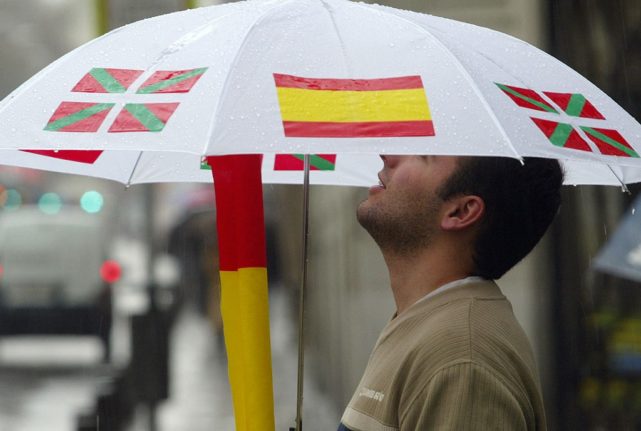Llover is the verb ‘to rain’, lluvia is the noun for ‘rain’ and lluvioso in the adjective ‘rainy’ . But you knew that already, right?
Spaniards may get on average 300 days of sunshine a year, but that doesn’t mean they haven’t got plenty of sayings and words to describe the different types of rainfall that go beyond saying está lloviendo mucho (it’s raining a lot).
In fact, the northwestern region of Galicia, which is largely considered the rainiest in Spain, has up to 70 different words for rain (although these are mainly in Galician).
READ ALSO: Where are the rainiest places in Spain?
So let’s have a quick look at some of the best rain-related vocabulary and expressions in Spanish!
Está chispeando
When Spaniards want to say it’s spitting with rain, they say está chispeando.
Chirimiri
Chirimiri is how people in certain parts of Spain (especially in the Basque Country) refer to constant drizzle, the kind of rain Britons and Irish readers are accustomed to. Another slang word for continued fine rain is calabobos. The standard noun to call this ongoing drizzle is llovizna.
¡Cae un diluvio universal!
This expression has hints of biblical references, it’s a bit like calling heavy rain a monumental downpour or saying that the heavens have opened.
¡Está cayendo la del pulpo!
This is perhaps the weirdest expression on our rainy weather list, and arguably the closest way to say ‘it’s raining cats and dogs’ in Spanish.
It literally means ‘the one of the octopus is falling’. The origin of this Spanish saying is just as bizarre as it refers to the act of bashing the octopus to soften its skin before cooking it.
¡Llueve a cántaros!
This expression is an equally common way to say that it’s raining very heavily.
A cántaro is a jug or pitcher in Spanish, similar to saying it’s bucketing down in English.
¡Llueve a mares!
Mares means seas in Spanish, another way of saying that a lot of water is coming down from the sky.
¡Está cayendo un aguacero/un chaparrón/un diluvio/una tromba de agua!
Whether it’s a downpour (aguacero), a shower (chaparrón) or a deluge (diluvio or tromba), heavy rain often causes inundaciones (floods) or una riada (flash food).



 Please whitelist us to continue reading.
Please whitelist us to continue reading.
Member comments